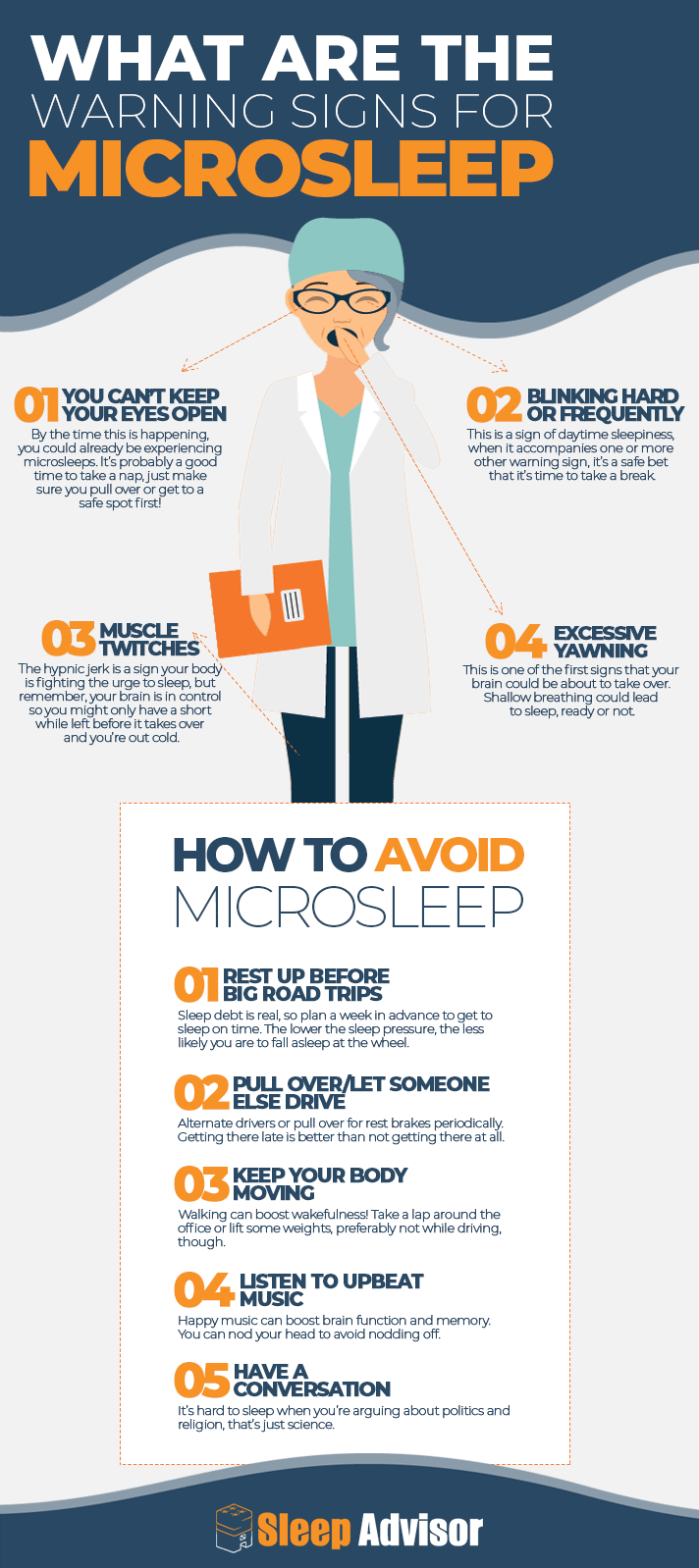You’ve probably heard people brag about being able to sleep with their eyes open, but have you ever heard of sleeping while you’re awake? We aren’t pulling your leg, it’s a real phenomenon and the craziest part is, you’ve probably done it.
We’ve all been there. Around 3 pm as your lunch is settling and the room starts to feel a little warmer, your eyes start to lose focus in the middle of your train of thought… then snap. Your head jerks upward as your eyes open wide and you ask yourself how long you were out. The truth is, microsleep is more dangerous than getting caught napping on the job.
What is Micro Sleep?
Whether it’s due to an after-lunch slump or an especially dry meeting, these lapses in our attention are called microsleep, and research shows they effectively disengage the brain from waking thought, putting ourselves and others at risk.
US & World Report News reports that this is because microsleeps are genuine episodes of sleep that would show up on an EEG. While not deep, these periods of unconsciousness are an involuntary reaction to a lack of rest.
Typical Duration
Microsleeps typically last between three to five seconds, and as they’re so quick in duration, sometimes you may not even be aware they are happening. In some cases, a person could be driving, talking, or even making eye contact with another person just before these microsleeps.
What’s Happening in Your Brain?
When we are sleep deprived enough, our brains have the power to take control and cause neurons to stop firing, like a power-switch, according to Dr. Clif Saper of Harvard Medical School.
When we fight our brains on this, we go through periods of sleep and wakefulness that only last a few seconds each, flipping back and forth between consciousness. A study conducted by the Emory University School of Medicine suggests that this phenomenon significantly interferes with cognitive performance, mood, and motor function.
Why Are You Not Aware That It’s Happening?
Microsleeps are sometimes classified local sleep, as evaluated in a research study by the Department of Psychiatry at the University of Wisconsin-Madison. The research showed that it’s possible to be sleeping while awake. This is possible because while a part of your brain may be sleeping, the rest can still be awake and fully functioning at the same time.
Additionally, BBC reports that sleep needs to last longer than one to two minutes for our brains to recall it, according to a sleepy driving expert. This means we could be experiencing microsleep without even noticing. They happen suddenly, and just as people use falling asleep as a metaphor for things that happen easily without any warning, microsleeps can sneak up on you.
Are Microsleep and Micro Naps the Same?
While microsleeps last a few seconds at the most, micro naps last a few minutes. Micro naps are voluntary short power naps that could potentially help a sleep-deprived person overcome nausea, and gain a bit of an edge on their sleepiness. Microsleep is an involuntary reaction in a sleep-deprived brain where the body leans toward sleep homeostasis so heavily that neurons stop firing as the brain takes control for a few seconds, putting lives at risk.
Why Is It Dangerous?
If you’re like most of us, around this point you may be frantically asking yourself what happens if I experience microsleep? Or has it happened already? While the answers might not be comforting, it’s important to understand the risks.
Microsleeps are involuntary and a result of the brain effectively revoking awake privileges for those of us who can’t seem to get enough sleep at night. When these instances occur on the road or while operating machinery, the risk for mistakes is amplified along with the seriousness of the consequences. Three seconds at sixty miles per hour is long enough to travel three hundred feet in the wrong direction, whether that’s into a ditch, off a cliff, or into a pedestrian.
There are more risks than just motor vehicle operation, however. These microsleeps can happen at work while editing spreadsheets, entering important data, or handling sensitive information.
While we fight our brain’s attempts to sleep, we tend to make more mistakes, according to a study performed on rats. In the study, the rats experiencing periods of microsleep were much less successful at tasks that required them to reach sugar pellets than rats who were fully awake. Applied to humans, microsleep seems to complicate even the normally simple daily tasks.
A study performed at the New Zealand Brain Research Institute shows that microsleeps include a complete failure to respond to external stimuli during the sleep episode, meaning for those working in a kitchen, sharp knives, hot stovetops, and slippery floors are all hazards.
Who Is Most at Risk?
Sleep-Deprived
The Harvard Business Review reported that microsleeps are caused by the brain leaning toward sleep homeostasis as triggered by the circadian rhythm. This generally happens when subjects are sleep deprived and cannot stave off sleep any longer.
Sleep deprivation is the biggest contributing factor to microsleep, meaning those who are often kept up through the night due to insomnia, or other medical conditions that restrict sleep are at a higher than normal risk for the dangerous phenomenon.
People with Sleep Apnea
Sleep apnea is a condition where breathing is restricted during sleep either due to breathing obstruction or other factors that cause a sleeping person to periodically stop breathing. This condition is serious and keeps the brain from getting enough oxygen during sleep, meaning those with sleep apnea may experience a higher than average level of daytime sleepiness.
If you are having trouble with sleep apnea, check out our list of best mattresses for sleep apnea.
A study conducted in Germany in 2008 found that those with sleep apnea are at twice the risk for microsleep related auto accidents than those without the condition.
Night Shift Workers
What does a truck driver, a doctor, and a new parent all have in common? Working the night shift. No matter what your profession, many of us have to do it at some point in our lives, and it’s important to recognize that it can put you at a higher risk for microsleeps.
Working through the night throws off your body’s internal clock. Triggered by sunlight, temperature, and a variety of other factors, your body is optimized to stay awake during the day and sleep at night. When this rhythm is changed, your body may experience microsleeps even if you slept a normal amount during the day.
Shift Work Disorder is a condition that increases sleepiness, insomnia, and microsleeps in workers who frequently change shifts, making it difficult for the body to accurately keep time and facilitate sleep.
Drivers
Whether you’re driving the long leg of a road trip, or just heading to the grocery store, driving with sleep deprivation is a dangerous endeavor, and there is currently a list of people doing time in jail because they felt they could handle it. According to the National Highway Traffic Safety Administration, there were an estimated 91,000 crashes due to drowsy driving in 2017.
Remember
Performing monotonous tasks for long amounts of time has been shown by research to be conducive to microsleeps, meaning driving alone for extended periods without anything to keep you awake may not be the best idea.
What Are the Warning Signs?
According to Healthline, there are a few key indicators that can signal you are about to experience an episode of microsleep. If you find yourself experiencing any of the following, we recommend you stop what you are doing and take time for a power nap.

If You Can’t Keep Your Eyes Open
As sight is a necessary element for operating a vehicle or performing dangerous tasks, this is a good indicator that you need to take a break. The New York Times has
that letting yourself nap will decrease the risk of errors or accidents and often boosts productivity.
Yawning Excessively
This is a surefire sign that your effectiveness is decreasing, and it’s time to quit while you’re ahead. While we still don’t know exactly why yawning is so contagious, we do know it’s strongly associated with sleep or boredom. Dr. Anthony Komaroff of Harvard Medical School says this is likely because yawning is an indication of shallow breathing, something that accompanies sleep preparation, or relaxation.
Muscle Twitching or Jolts
Called the Hypnic Jerk, sudden jolts that yank you out of the falling asleep stage are common and indicate your brain has been and will continue trying to fall asleep. We don’t know exactly what causes them, but if they’re happening while you need to be awake, it’s important to call it quits and turn off the lights.
Blinking Hard to Stay Awake
According to a study conducted at the Clinic Charité-University Medicine in Berlin, rapid eye blinking is a reliable indicator in daytime sleepiness. If you find you’re blinking more frequently and quickly as a means to focus on your tasks, it’s a good time to put a pin in the task at hand and take time for a nap.
How Do I Avoid Micro Sleeping?
The good news is that micro sleeping is completely avoidable, and with a few good habits, you can avoid the risk of harm or injury.
Rest Before Big Road Trips
If you know you’re going to be driving significantly more than usual, especially late at night, it’s important to make sure you get plenty of sleep in the week before the trip. If you’ve stayed up all week long but gotten eight hours the night before, you may want to reschedule, as sleep debt is a major factor in causing microsleeps.
Pull Over/Have Someone Else Drive
If you find you have been experiencing one or more of the aforementioned risk indicators, you can pull over to take a short nap and recharge for a while. If you have another passenger in the car who is more awake, taking turns napping and driving can be effective in preventing microsleep. If you want to be extra cautious, the National Safety Council recommends limiting the amount of time driven at night due to the volume of accidents, especially for older drivers.
Keep Your Body Moving
If you find yourself feeling extra tired after a heavy lunch, getting up for a brisk walk can help boost your body’s wakefulness. According to a study conducted at the University of Georgia, walking up a flight of stairs can be more energizing than caffeine for young women.
Listen to Upbeat Music
According to a study conducted by Leigh M Riby, upbeat music is great for stimulating the brain and can boost alertness, attention, and even memory. The study was done on Vivaldi’s four seasons, so if you’re feeling a little weary, telling Siri to play Vivaldi’s “Spring” may not be a bad idea.
Ask Someone to Talk to You
Asking a coworker or other car passenger to have a conversation with you can help keep you awake. Topics such as religion and politics may be stimulating enough to stave off the sleepiness.

Katie Harris
Content Writer
About Author
Katie writes content at Sleep Advisor, where she has finally found people who appreciate her true passion for sleep. Based in Austin, Texas, she graduated with a degree in Communications and enjoys combining creativity with research to improve the world’s sleep, starting with her sleepwalking husband.
